Chimney clogging reasons
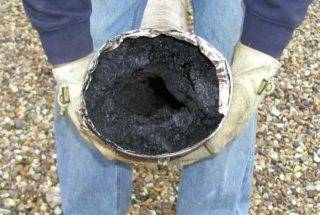 Soot can completely clog the chimney, so cleaning is done once a year.
Soot can completely clog the chimney, so cleaning is done once a year.
Combustion of fuel requires sufficient carbon oxidation. This process requires high temperature and oxygen. If one of the conditions is violated, soot is formed, which clogs the chimney.
Reasons for the formation of plaque on the pipe:
- Use for burning raw firewood. In this case, when they enter the oven, they begin to dry, which consumes a large amount of energy. As a result, the temperature goes down, the carbon does not warm up well and soot is formed.
- Incineration of plastic and polyethylene, as well as scraps of plywood, chipboard and OSB. They contain substances that clog the chimney.
- Weak cravings. Insufficient height of the pipe leads to it, the conversion of the combustion process to decay and the accumulation of soot deposits.
Dry Cleaning: Caution Needed!
But it so happens that soot is difficult to clean, especially if old wood was used, and then you have to resort to the chemical method. The advantage of this method is that it does not take up your time or your energy.
A variety of special products for chimney cleaning today pleases the eye: liquids, briquettes, special powders. Their secret is that such substances are ignited in a heating device and they emit active gases, which soot is afraid of. Under their influence, it becomes fragile and begins to fall away. Moreover, some of the small particles simply fly out along with the smoke, and the rest falls down and is already removed along with the ash.
Powders are simply thrown into the firebox without unpacking, right with the firewood, and there should be a lot of firewood itself. You only need to drop one sachet every two to three weeks. The only limitation of this method is that it makes sense to use a powder product only if the soot on the walls of the chimney is no more than 2 millimeters. But if you use such a powder constantly, you will not need to clean the chimneys at all:
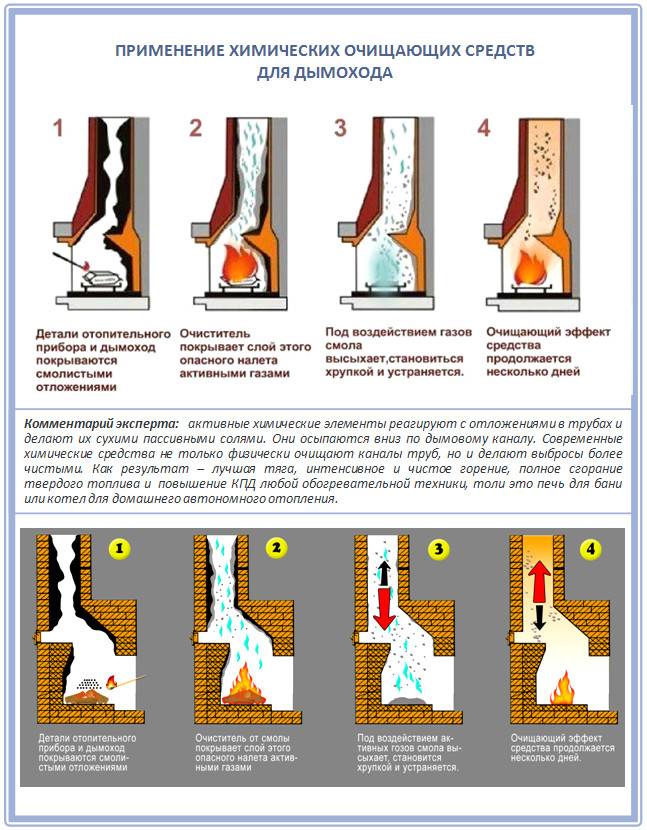
But if you have a deeper problem, then you will have to use a log - this is a chemical substance in the form of a briquette, which is enough to put in the firebox once every two months, also in a package. It is used when the wood has already burned out in order to set it on fire separately. In the composition of such a log, wooden saws, urea, sodium sulfate, coal wax, ammonium sulfate and amorphous silicon.
Such a composition of active substances is able to remove all accumulated soot in the chimney in just one time. After you burn the chemical log inside the firebox, for another two weeks, soot will fall off the walls of the chimney, and it will simply need to be removed.
Very convenient: just put the log in the fire, and the chemical gases corrode the soot not only on the surface of the chimney walls, but also inside the heater itself, even on the heat exchanger and the internal chimney. And in its own way even prevents the appearance of new soot. It is this method that allows you to remove soot in the most difficult to reach places of bends and knees. And, most importantly, such cleaning can be done at any time of the year - even with an active winter firebox. The only point: if the chimney has not been cleaned for a long time, you clearly feel a blockage and there is almost no draft, then first you will still have to use a brush.
Here is a good example of how to clean a chimney with modern chemicals:
How to know if you need to clean your chimney
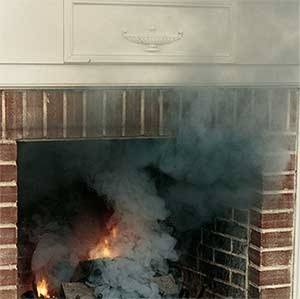 If you do not clean the chimney, then the roughness of the walls becomes larger, the force of air friction against the side surfaces increases. The thrust force is spent on overcoming this resistance, and as a result, the rate of exit of combustion products decreases, the air consumption for heating decreases.
If you do not clean the chimney, then the roughness of the walls becomes larger, the force of air friction against the side surfaces increases. The thrust force is spent on overcoming this resistance, and as a result, the rate of exit of combustion products decreases, the air consumption for heating decreases.
The temperature in the firebox drops, the house becomes cold. Instead of unclogging the canal, the owners of the private house begin to add fuel.All of the above reasons lead to a violation of traction, which is manifested in the following performance indicators:
- The amount of heat in the house remains constant, but more fuel is needed to achieve this.
- From hot gases, soot in the pipe can ignite and cause a fire.
- Burning soot emits black smoke visible from the chimney, and absolutely dry fuel can be loaded into the furnace.
- The color of the flame turns to a dark red hue, which indicates a lack of supply of fresh oxygen due to reduced thrust.
The chimney in the house should be cleaned only if it removes the combustion products of solid fuel. In the event of combustion of gaseous fuel in the chimney, there are other problems associated with the formation of condensation.
It is considered the norm to clean the chimney from soot once a year, this is done in any way at the beginning and end of the season, which prevents major cleaning or even disassembly of the chimney.
Cleaning the glass of the fireplace
How to clean the glass of the fireplace? The first question that arises before users. And this is not surprising, because closed-type fireplaces need to be cleaned much more often than open fireplaces. Cleaning procedures must be carried out regularly, because the slightest dirt will be immediately noticeable on the glass fireplace screen.
First you need to figure out: why is the glass smoked in the fireplace?
The reason for the formation of dirt on the glass of the fireplace insert can be several:
- If the fireplace is running on gas fuel, soot and soot indicate that the burners are clogged or the jets are not positioned correctly. All these shortcomings affect the fact that the air and gas are correlated incorrectly, and as a result, soot settles on the inner walls of the furnace.
- Units operating on propane are even more susceptible to the formation of dirt than gas pockets. And most often the main reason lies in low-quality fuel, clogged burners and damage to the regulator tank.
- Fireplaces fueled by wood. Soot is most often formed on the glass of such devices. This is usually due to the fact that conifers are used as fuel. Another reason is the lack of openings for air intake.
- Soot can also occur as a result of contamination in the flue gas pipe.
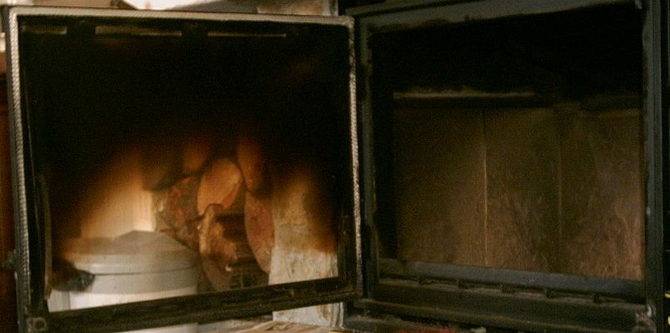
Soot on the glass of the fireplace
To cope with the problem, you need to know how to clean the glass of the fireplace.
Fireplace glass cleaner is an excellent solution to this unpleasant situation. Today, a wide variety of chemicals are sold that will successfully cope with deposits of soot and soot.
When choosing a cleaning agent, look at the composition: it should not contain any aggressive components that can damage the glass.
What else can you clean smoked fireplace glass besides special chemical compounds? You can use your usual dishwashing detergent, but you have to try hard here.
Another great remedy is ammonia, which cleans up the soot well.
The stages of cleaning glasses with ammonia are as follows:
it is necessary to wait until the fireplace has cooled down, it is important that the door is cold; then in the container you need to mix the ammonia and water, add a small amount of vinegar to the mixture. The resulting composition must be filled with a spray bottle; then just spray the liquid on the glass and wipe it with paper towels.
There are other methods of cleaning glass from soot:
There are other methods of cleaning glass from soot:
- The fire is ignited at full power until the flame burns the soot that has settled on the glass. This technology will not only effectively remove dirt, but also keep the chimney clean.
- The next method is that the newspaper is lowered into water and then into ash at the bottom of the firebox.Then you need to apply it to the contaminated area and rub until you remove the plaque. After finishing the cleaning process, wipe the glass with a dry cloth. It should be noted that such a process is quite laborious and time consuming, but effective.
Follow a number of simple rules and you will have to clean the glass fireplace doors much less often:
- Every time after stopping the fireplace, wipe the door clean. Thus, you can avoid long-term routine cleaning of glasses when soot accumulates.
- To keep the glasses as clear as possible, wash them with regular soap. After each cleaning, apply soap to the glass. As soon as the fireplace heats up, all soap streaks will dissolve and the glass will become transparent.
- In order to bring the glass to the formation of strong soot, fireplaces should be heated only with clean and dry wood.
- When using the fireplace, use the “clean glass” method. It is based on the need to make a narrow slit on top of the glass. When air penetrates through it, an invisible barrier will be formed, which will prevent the appearance of plaque. There is a door with similar holes on sale.
Knowing how to clean the glass of a fireplace from soot, you can get rid of dirt at any time.
Therefore, there is nothing difficult in cleaning the fireplace.
Mechanical tools
If the chimney opening is very narrow or there is a large blockage, then the chemicals may be useless. In such a furnace, there is no draft, and the smoke goes inside the room. It is dangerous to use it, since deposits on pipes burn out with strong heating, a sheaf of sparks flies out, which can cause a fire. In this case, mechanical pipe cleaning will help. It is produced using special tools. It can be a variety of scrapers, ruffs, brushes. Special kernels are used to break through large and dense blockages. All this can be bought or made by yourself.

The flue ducts are cleaned from top to bottom. The work is carried out in the following order:
- break through large blockages with the core;
- clean pipes with scrapers, brushes and brushes;
- smoke channels are cleaned through the doors;
- clean the dampers, firebox and ash pan.
We remove soot using folk methods
But what if you don't have the opportunity to go to the store for chemicals to remove combustion residues? In this case, you can use folk remedies that have shown their effectiveness in cleaning the chimney for more than a decade. The simplest option is to use rock salt. You just need to sprinkle fuel (wood or coal) in the combustion process. True, salt is best considered as a preventive measure - it is not very effective in removing deposits.
They are much better at dealing with soot and plaque on the walls of potato cleaning. The process of using them is very simple: we heat the stove well and throw a bucket of cleanings into the fire, you can even pieces of potatoes. The soot will decompose under the influence of the generated steam - small particles will fly upwards, and those that are larger will remain inside. All you have to do is remove their remnants.

An excellent tool in the fight against plaque in the chimney is aspen firewood. To remove the soot, simply burn a few armfuls of wood. However, in this case, you need to be careful, since cleaning with wood leads to the formation of a high temperature, as a result of which the soot will begin to ignite.
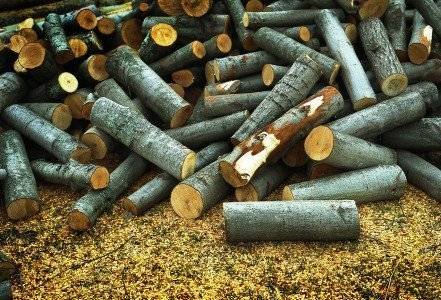
We introduced you to the basic means and methods for cleaning soot from a chimney. We hope you and your fireplace benefit from our recommendations.
We remove dirt with folk remedies
The most unpleasant consequence of fuel combustion is a dense layer on the glass, representing fumes and soot.Due to the fact that the basis of this plaque is creosote, which, like a magnet, attracts soot particles to itself, a simple treatment with wet matter will not help here. We have to resort to the accumulated experience, because we have always faced similar problems.
- If the glass has been smoked recently, and the soot layer did not have time to dry in the creosote, then it is quite possible to use self-cleaning, which consists in burning dry deciduous wood with a large access of air. To do this, you need to open the blower door for the whole. At high temperatures, the soot particles are burned and the glass is freed from soot. But this method is good only if you find out in a timely manner that glass cleaning is required.
- Water and vinegar are mixed in equal parts. The resulting solution is poured into a spray bottle. will have to be dismantled and placed on a horizontal surface. A layer of newspapers is applied to the smoked areas. With a vinegar solution, these newspapers are soaked and aged for some time. Then the glass should be treated with wet newspapers, like matter.

During work, be sure to use rubber gloves.
Sometimes ash taken from an ash pan is used to clean the glass. It is known to form an acidic environment. Under the influence of chemical reactions, carbon deposits are broken down and the surface can be washed off. For the convenience of work, use a sponge. Ash must be free of dirt, otherwise the glass may be scratched. Ash is poured onto a moistened sponge and the surface is treated with gentle movements. If necessary, wash the sponge well and add a new portion of ash again. Another recipe for making a soot cleaner for a fireplace glass door is based on mixing ammonia, vinegar, lemon and soda. First, the carbon layer must be moistened, after which we clean the soot with ease
It is important to remember that an increased concentration of ammonia will make it possible to make a more active solution, and cleaning the glass will be easier, but the ammonia will quickly evaporate, and this fact will have to be reckoned with.
Mechanical chimney cleaning: only in the warm season
As a rule, ordinary owners of stoves and fireplaces clean their chimney once, before each heating season, and it is good if this is enough. And the mechanical method is the oldest and even today it makes sense:
You can manually clean the chimney from inside the house, from below, or from above, directly from the roof. And for each of the methods there is a tool.
If you chose the brush that is used from above, you need to tie a rope to it and hook a load on it, and only then run it into the chimney through the roof. This will go along the entire chimney and hook with soot from the walls.
It is only important to lower the brush at the same time carefully and gradually, slowly, so that the soot collects efficiently and at the same time the load does not damage the chimney itself. In the same way, lower and raise the ruff several times until it becomes noticeable that the soot is cleaned and the blockage is broken.
Usually, such a brush is enough for up to three heating seasons. But this method has its drawbacks:
- Firstly, you will need a lot of time for all this, at least an hour;
- Secondly, if you need to clean the chimney, you will not always be able to get out onto the roof, especially when it is snowing and the wind is strong;
- And, finally, with such a device it is rather difficult to clean the chimney elbows and hard-to-reach places, or the chimney itself is designed in such a way that it is generally impossible to clean it from the outside, through the roof.
And the method of cleaning the chimney from below, from the room, is much safer for a person. You can easily do all the necessary work and not risk your life. Just take the brush, place it on the flexible holder and push it through the heater or through the special inspection hole.
In addition, from the bottom, with the help of long flexible holders, the soot can be easily cleaned even in high bends:

So, for example, a brush with a telescopic holder is good because it is convenient to use it on the roof: you just need to insert one part into another, gradually lowering the brush down, and disassemble in the reverse order when going up:
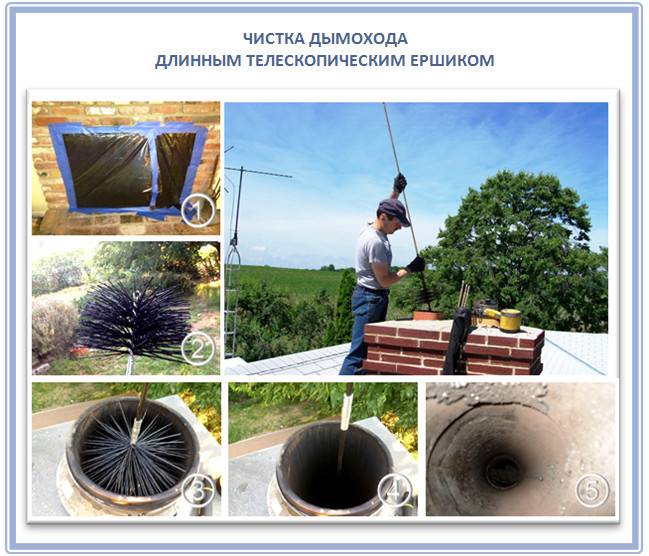
Here is a step-by-step illustration of what is needed to mechanically clean the chimney with a brush and a load:
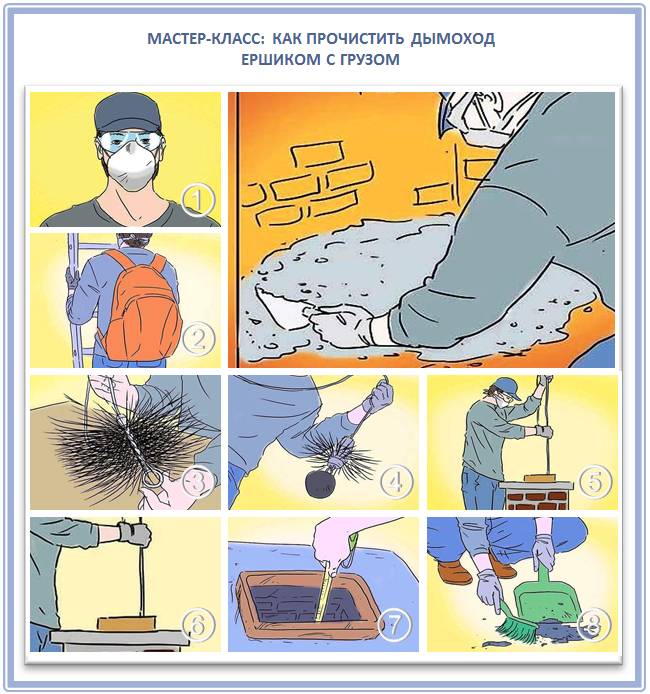
From grout on brick
It is best to remove the grout from the brick surface immediately. If a day has passed after application, then you can slightly moisten the contaminated areas with water, wait 20 minutes, then clean with a spatula.
If much more time has passed, then you need to act according to the scheme:
- Purchase a special solution in the store and dilute it according to the instructions.
- Apply to the surface.
- Wait a certain amount of time.
- Clean with a spatula.
You need to act carefully and not overexpose the product for longer than the prescribed time. Before starting work, it is best to glue the seams with thin masking tape so that no chemical agent gets into them.
Why is it necessary to clean the chimney?
The state of the structure determines the safety of people living in the house. Carbon dioxide is invisible and odorless, but highly toxic - its effects on humans can be fatal. The quality of work of a fireplace or stove directly depends on the state of the chimney in the house, especially if you did it yourself. Over time, the area of the lumen of the channel through which the smoke comes out begins to decrease, decreasing the thrust force. If the opening becomes too small, it may cause the fireplace to malfunction.
There are other reasons why the chimney must be cleaned. First of all, over time, the walls of the structure will begin to collapse, including due to the high temperature regime and chemical reactions. Due to the large amount of soot, you are unlikely to be able to react in time to the appearance of defects on the walls. Soot on the surface also interferes with good traction, resulting in a significant increase in warm-up time. This, in turn, leads to excessive consumption of fuel.
If there is a lot of soot inside the chimney, flames will appear - this can cause a fire. Now you know why work to remove soot and other foreign objects from the chimney must be carried out regularly. And now we will tell you which tool for cleaning chimneys is better to buy, as well as share folk "tips" for cleaning.

Special cases of chimney cleaning
Some chimney cleaning situations require separate consideration.
How to clean a chimney in a private house
Briefly above, the whole process of cleaning the chimney has already been described. To what has been said, it is only necessary to add that in case of severe clogging of the smoke channel, the first operation is to pierce the carbon with a core without additional devices. Only then are brushes of various sizes and designs consistently used.
When performing work, care should be taken to create a safe working environment.
 When working at height, be sure to fasten with a safety rope.
When working at height, be sure to fasten with a safety rope.
Video: how to clean a chimney in a private house
Chimney cleaning in the bath
The chimney in the bath is usually simpler. And most often it is made from stainless pipes, which requires special attention to its cleaning. In order not to negate its main advantage - high quality of the inner surface - you should clean only with soft plastic or brushes made of natural materials. The easiest way to handle straight pipelines, and in the presence of elbows - recall that there should be no more than two of them - you may have to dismantle the chimney if it does not have special windows for cleaning during installation.
Otherwise, preventive measures and cleaning are done in the same way.
Cleaning the chimney from tar
Considering the composition of flue gases, you need to pay attention to two main components - water vapor from the fuel and vapor of hard-to-ignite creosote. Mixing and settling on the walls of the smoke channel, they form a resin that is difficult to remove due to its viscosity and good adhesion to various types of surfaces.
The only effective way to combat resin deposits is to prevent its formation. For this, various means are used, produced specifically for this case.
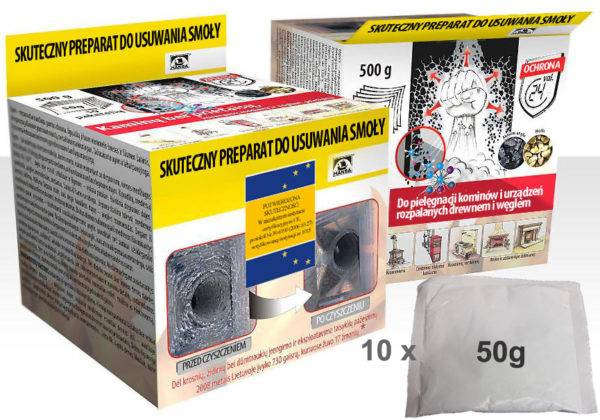 HANSA effectively protects chimney walls from tar formation
HANSA effectively protects chimney walls from tar formation
For example, the known composition of HANSA is a fine crystalline substance. Part of it turns wood into resin and water vapor, and the second, reacting with the resin substance, promotes its decomposition and combustion at the temperature in the oven. Residual resin on the walls turns into a brittle crystalline composition that crumbles inside the furnace.
This composition is placed inside a burning firebox. The frequency of use at the beginning of the operation of the heating unit is daily, then you can switch to use once a week.
Clearing a bent chimney
The bends of the flue duct are always a forced measure due to the structural features of the building. However, periodic cleaning is necessary. For this, elements are provided in the pipeline design, using which this operation can be performed easily and simply. These are special hatches, when opened, it becomes possible to access the straight section of the bend. It is not recommended to make the length of inclined sections more than a meter in size. The number of bends on one pipe should not exceed two.
 If there is no window for cleaning on the outlet bend, then the chimney will have to be disassembled
If there is no window for cleaning on the outlet bend, then the chimney will have to be disassembled
How to clean the chimney of a gas column
The reason for cleaning the chimney of the gas column is its banal clogging with a deterioration in draft. In a city apartment, this is all the more dangerous because the threat arises for many people at the same time. One of the signs of a deterioration in thrust is the "flapping" of the column igniter.
The process of cleaning the chimney from the gas unit is practically no different from such an operation with conventional chimneys. The same brush is used. Recently, vacuum cleaners of a special design are often used, which reliably clean the pipe surface and collect pollution products. In difficult cases, when the layers cannot be removed with a brush or vacuum cleaner, special chemical agents are used to soften and remove them. Given that the use of prophylactic agents on the column pipe is impossible, urgent measures should be taken if signs of clogging are detected.
It must be admitted that the success of the use of solid fuel furnace equipment to the greatest extent depends on the correct operation of the units and the careful selection of fuel for it. In addition, it is necessary to regularly use preventive measures and know how to get rid of problems with clogged chimneys. Then stoves and fireplaces will delight you for a long time with the gracious warmth in the house. I wish you success!
Signs of a clogged chimney
When the flue gas duct becomes clogged, it will be immediately visible. The main signs of a clogged channel will be the following phenomena:
- Decreased traction in the stove or fireplace. It is necessary to check the gate, and if it is in the open position, it means that the cleaning of the pipe is overdue.
- The gradual attenuation of the flame in the furnace of the heating unit.
- Difficult fuel ignition. If you use dry wood and they don't burn, then the chimney is most likely to blame.
- Changing the color of the flame in the furnace. You should especially be on your guard if it has acquired an orange blossom.
-
Strong unpleasant odor. If corrosive smoke appears in the room during the heating process, it means that carbon monoxide (carbon monoxide) gets into it. In this case, the room must be well ventilated, the firebox must be interrupted and measures must be taken to clean the chimney.
What to do if the chimney is clogged
Before the start of the heating season, it is imperative to inspect the inside of the chimney for blockages. In the warm season, birds with a nest can settle in it, or garbage can appear, blown into the chimney by the wind. To avoid this, the chimney should be equipped with a head with a mesh at the installation stage to prevent such situations.
In such a case, the house should always have a backup heating unit in the form of an air heater or an electric heater built into the heating system.
Having provided yourself with heat with its help in the cold season, you can thoroughly consider the situation and think over options for getting out of it.
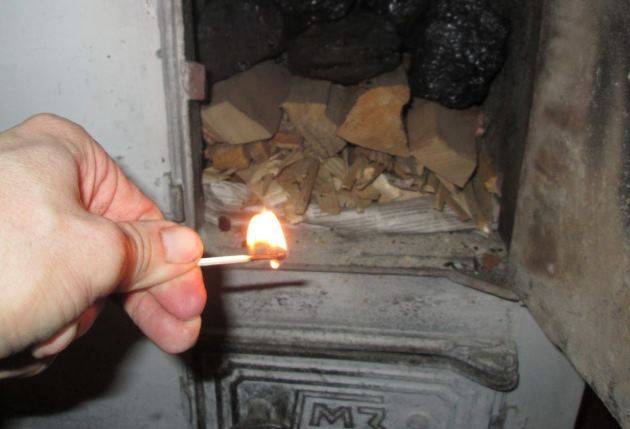
The presence of a draft in the firebox must be checked every time the stove is fired - the flame must deflect towards the chimney
Is it possible to avoid soot
Let's immediately answer the question with denial, because the release of combustion products is characteristic of any type of fuel to a certain extent, and we will talk about this degree in more detail. Using gas to operate the fireplace, many deny the reality of a real hearth. But they compensate for this with rare device maintenance sessions. Even if glass is smoked, it is very slow compared to wood-burning models
But if the time has quickly come to clean the door, then you should pay attention to this fact.

Cleaning after use
Why does soot form at all? The fact is that the fuel does not burn completely. The more oxygen supplied to the furnace, the better the oxidation reaction takes place. Carbon deposits indicate a lack of oxygen. In the case of a gas fireplace, the dosing is controlled by the nozzles. One thing can be said about the wood-burning fireplace - the chimney is clogged or the ash pan is not cleaned. Although such a procedure as cleaning the chimney also awaits the owners of gas equipment.
Different tree species, of which, contain different amounts of resin. When they are burned, soot is formed, which settles on the glass. Therefore, it is recommended to stock up on hardwood firewood. Dry the logs well before using. Excessive moisture levels cause poor combustion and soot production.
If you find it is time to wash the glass on the door, try adding a handful of salt to the wood first. This method was often used in the past to soften the soot before cleaning the chimney. There are special fuel additives that inhibit the formation of soot. This is a kind of catalyst for additional combustion of secondary products.
Make it a rule to remove light deposits immediately after the fireplace has gone out and cooled. Daily cleaning is better than drastic action in case of contamination. After regular cleaning, apply a soapy solution to the glass; you do not need to wash it. The next day, after lighting the fireplace, the glass will become transparent on its own. When designing the firebox, a small gap is left at the top of the fireplace opening through which part of the air enters the chamber. This part, with its flow, prevents soot from settling on the door.
13.06.2017
4427
Pechnik (Moscow)
A heating installation with a closed type of combustion chamber is more whimsical to maintain. This is due to various formations, which are easy to eliminate, knowing what methods need to be applied. Fireplace glass cleaner is a great opportunity to quickly and easily remove any dirt and formations from this surface.
Cleaning the glass of the fireplace from soot must be carried out in accordance with certain rules. This will preserve and preserve the glass surface. You can learn more about the cleaning methods, the compositions used and the reasons for the frequent occurrence of this problem later in this article.
Choosing a means for cleaning the glass of the fireplace from soot
An important role in the qualitative destruction of traces of dirt is played by the type of fireplace. Simply put, in order to wash off soot and soot gas and, for example, propane, you need a different method. Gas, unlike other fuels, emits the least amount of combustion products. Due to this, it is necessary to take up the rag much less often. At the same time, it is necessary to make a reservation that we are talking about high-class gas.
Even the smallest traces of soot indicate the need for immediate maintenance. Most likely, the chamber was depressurized.
Before buying one or another tool for cleaning the glass of the fireplace from soot, you should read reviews about it on the Internet.
If we are talking about a propane or wood-burning option, then the procedure is as follows:
- First, you need to choose a tool that allows you to remove the sticky plaque that is constantly forming in the oven;
- You can use a paste or spray that softens deposits;
- After that, you need to take a hard sponge and wipe the surface.
Gas fireplaces practically do not require cleaning, provided they are used correctly. If traces of burning do appear, then this indicates that the oven is not working properly. The situation is more complicated with propane fireplaces or their wood-burning counterparts. First, the sticky plaque softens, and only then the traces of soot are removed with a sponge.
